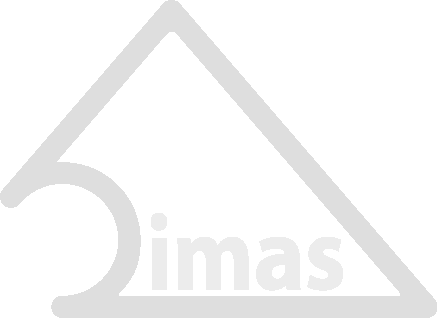Projects
World Forum Offshore Wind (WFO)

Johannes Dimas is the Representative Brazil within the World Forum Offshore Wind (WFO). He supports member companies in market entry and project development in Brazil.
| since 2020 |
| Project Owner: | World Forum Offshore Wind (WFO) |
| Function: | Representative Brazil |
WFO: 100% global

The World Forum Offshore Wind (WFO) is promoting offshore wind energy on a global scale.
The WFO is a non-profit organization, with offices in Hamburg, Tokyo, Taipei and New York. WFO’s international members represent the complete offshore wind value chain including utility companies, manufacturers, service firms as well as non-profit organizations.
Offshore Wind Energy Updates Brazil
The "Market Updates Brazil" for WFO member companies are workshops with up-to-date information on market developments and legal framework conditions. Furthermore, its an excellent opportunity for a high level exchange.
Economic Analyses Brazil
Johannes Dimas reported on the Brazilian market to Germany Trade & Invest (GTAI), the economic development agency of the Federal Republic of Germany. The economic analyses go beyond the energy sector and also include general economic aspects.
| 2020 − 2023 |
| Project Owner: | Germany Trade & Invest (GTAI) |
| Function: | Business Analyst Brazil |
Business Intelligence for Foreign Business Activities
In the course of this engagement, Johannes Dimas assessed the Brazilian solar, on- and offshore wind energy market. He did evaluate business and investment opportunities, as well as the potential of renewable resources for a green hydrogen economy in Chile and Brazil. In addition, he benchmarked the status quo of green hydrogen regulations in Latin America.
Apart from that, Johannes Dimas reported frequently on economic aspects such as the investment climate, logistics or the general economic structure.
Germany Trade & Invest GmbH
Germany Trade & Invest GmbH (GTAI) is the economic development agency of the Federal Republic of Germany and a 100% subsidiary of the German Federal Ministry for Economic Affairs and Energy (BMWi). With more than 50 offices in Germany and abroad, and its network of partners throughout the world, GTAI supports German companies setting up in foreign markets, promotes Germany as a business location and assists foreign companies setting up in Germany.
Business reports in German on Brazil, Chile and South America: Publications & Presentations
Johannes Dimas did already worked at the Berlin Head Office of GTAI between 2009 and 2011.
Business and Project Development in Brazil
Entering the offshore wind sector as a service provider is an obvious business field development for companies from the environmental services sector. Johannes Dimas supports Brazilian companies, one of which has become a project developer itself.
| 2020 − 2021 |
| Project Owner: | N.N. |
| Function: | Consulting and in-house training |
Geoinformation System for Offshore Wind Farms in Brazil

To develop suitable sites for offshore wind farms in Brazil, Johannes Dimas worked with Brazilian partners to set up a comprehensive geographic information system (GIS).
| 2019 − 2020 |
| Project Owner: | Johannes Dimas and Partners |
| Function: | Project sponsor |
Siting and Project Development
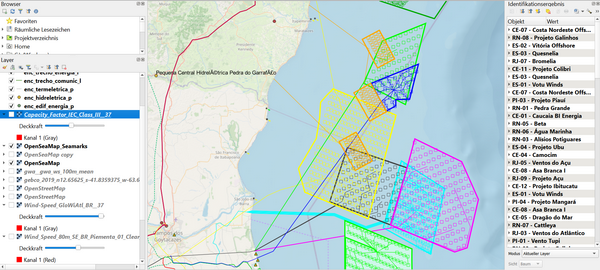
"Siting" refers to the process of finding locations for projects. The GIS system brings together the relevant information for siting and further project development.
The GIS system maps the entire Brazilian coast, including the hinterland and transmission network. Thus, along the several thousand kilometers of coastline, suitability areas - so-called "hotspots" - were first identified on the basis of important criteria. In subsequent steps, the best locations were narrowed down further and further
The criteria considered include:
- Wind potential and yield forecasts
- Water depths (bathymetry)
- Soil relief and composition
- Grid connection, potential feed-in points and planned grid expansion
- Distance to suitable construction ports
- Competing uses (oil & gas, cable routes, pipelines, shipping, marine, tourism, protected areas, etc.)
- Environmental impact
- Distance to suitable maintenance ports
- Potential private customers, including green hydrogen production and shipment
Brazilian Offshore Delegation 2019
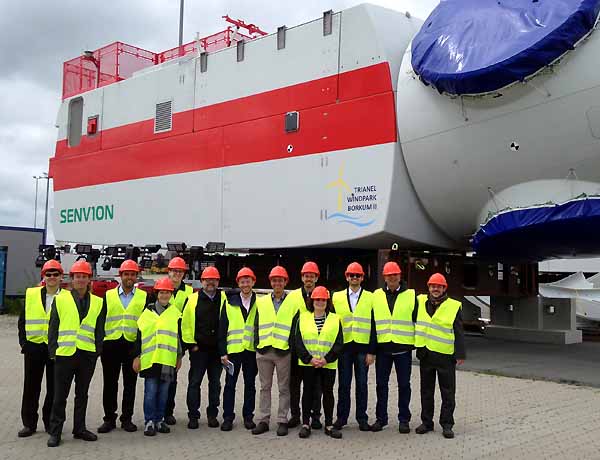
The first "Missão Técnica Eólica Offshore" to Germany established a high-level professional exchange between Germany and Brazil.
| 2019 |
| Project Owner: | Chamber of Commerce and Industry Brazil-Germany in Rio de Janeiro (AHK-RJ) in cooperation with Johannes Dimas – Energy & Project Management |
| Function: | Organizer |
Brazilian Offshore Delegation Missão Técnica Eólica Offshore 2019

The first expert trip Missão Técnica Eólica Offshore to Germany took place in May 2019 and established a high-level professional exchange between Germany and Brazil. Next to big players like Petrobras and Mitsui, around 10 medium sized Brazilian companies and research institutes took advantage of the expert trip, organized in cooperation with the Chamber of Commerce and Industry Brazil-Germany in Rio de Janeiro (AHK-RJ).
The trip provided the participants with a deeper understanding of the technical and environmental regulatory framework of the offshore wind energy sector in Germany and how this combines with the new technologies, trends, as well as with the financing and insurance sector.
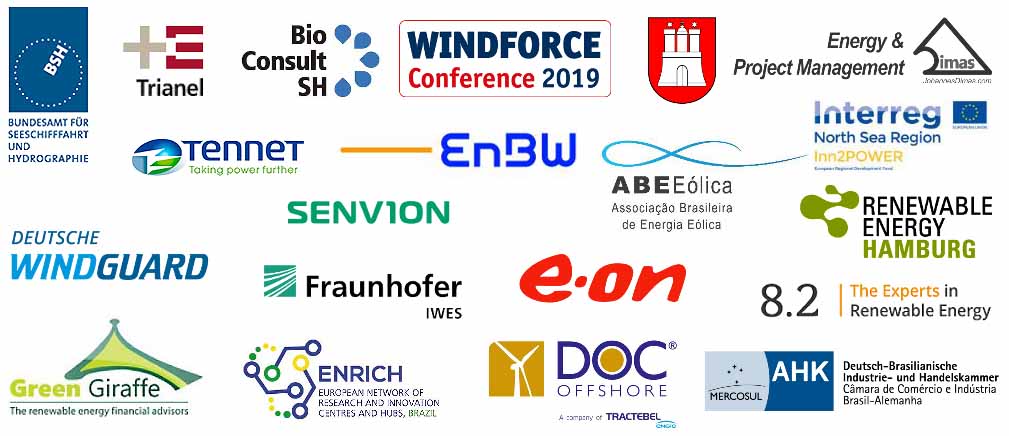
The Hamburg Renewable Energy Cluster (EEHH) organized the closing event in the historic St. Pauli Landungsbrücken. Amongst others with Michael Pollmann (Council of the State of the Free and Hanseatic City of Hamburg - Department of Environment and Energy), Dr. Jan Curschmann (Honorary Consul for Brazil), Holger Matthiesen (Managing Director of E.ON C&R) as well as with GreenGiraffe, and the 8.2 Group.
Program website of the Offshore Wind Delegation in 2019
Lectures Offshore Wind Energy

Johannes Dimas is promoting actively the development of the offshore wind energy sector in Brazil. Therefore he is also engaged in the field of education and professional training.
| 2018 − 2019 |
| Involved: | Chamber of Commerce and Industry Brazil-Germany in Rio de Janeiro (AHK-RJ), COPPE de Universidade Federal do Rio de Janeiro (UFRJ), Instituto Superior de Inovação e Tecnologia (ISITEC) |
| Function: | Guest Lecturer |
Guest Lectures in Rio de Janeiro

Johannes Dimas lectured in the year 2018 and 2019 as part of the postgraduate courses European Energy Manager (EUREM) and Gestão de Energias Renováveis (GENRE).
Both curses offered by the Chamber of Commerce and Industry Brazil-Germany in Rio de Janeiro (AHK-RJ) together with the institute COPPE of the Universidade Federal do Rio de Janeiro (UFRJ), and before in 2018, together with the Instituto Superior de Inovação e Tecnologia (ISITEC).
Offshore Wind Farm TWB II
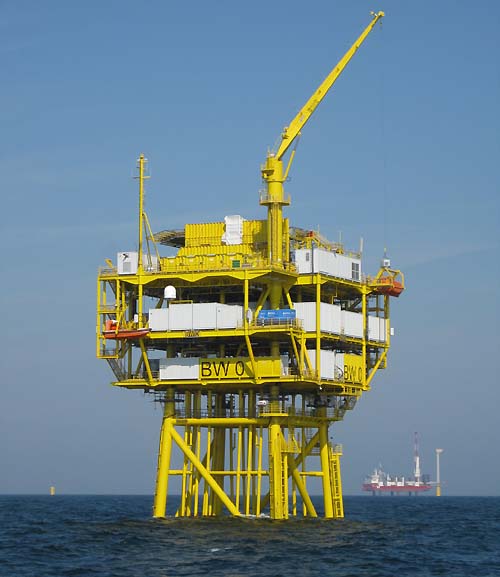
The offshore project in the German Bight consists of 32 converters with a total installed capacity of about 200 MW and will produce 800 GWh per year.
| 2014 − 2017 |
| Project Owner: | Trianel Windkraftwerk Borkum II GmbH & Co. KG |
| Function: | Project Director |
Trianel Windpark Borkum II (TWB II)

The offshore wind farm Trianel Windpark Borkum II (TWB II) is the second construction phase of the Trianel Windpark Borkum. The first phase (TWB I) went already online in 2015. TWB II consists of 32 Senvion Wind Energy Converters (WEC) of the type Senvion 6.2M152 Power Upgrade with a nominal output of about 6.3 Megawatt (MW) each. The offshore site covers 56 square km and is located about 45 km north of the island Borkum in the German Bight. TWB II with a total installed capacity of about 200 MW will produce 800 GWh per year.
The supply and service contracts were already closed in September 2016. The offshore construction started in June 2018 with the installation of the monopile foundations. After several months of delays due to the bankruptcy of the turbine supplier Senvion, the last wind turbines were errected in May 2020.
The project was developed initially by Trianel Windkraftwerk Borkum GmbH & Co. KG, which later agreed a joint venture with EWE AG, a northern German utility. In April 2017 the shareholder board approved the start of construction (Baubeschluss) followed by Financial Close (FC). Shareholders of the special purpose vehicle (SPV) Trianel Windkraftwerk Borkum II GmbH & Co. KG are European utilities (EWE AG, ewz, Trianel GmbH and further 17 regional utilities) and FONTAVIS, an independent Swiss asset manager.
Success Through Cooperation
Johannes Dimas was Senior Manager at Trianel GmbH and had responsibility for the business and portfolio development of the offshore division in Hamburg. He was the technical Project Director of TWB II up to achieving the successful joint venture with EWE AG.
Videos about the project TWB II
Jump to the description of the first construction phase TWB I
Website of TWB II (in German): www.trianel-borkumzwei.de
Offshore Wind Farm TWB I
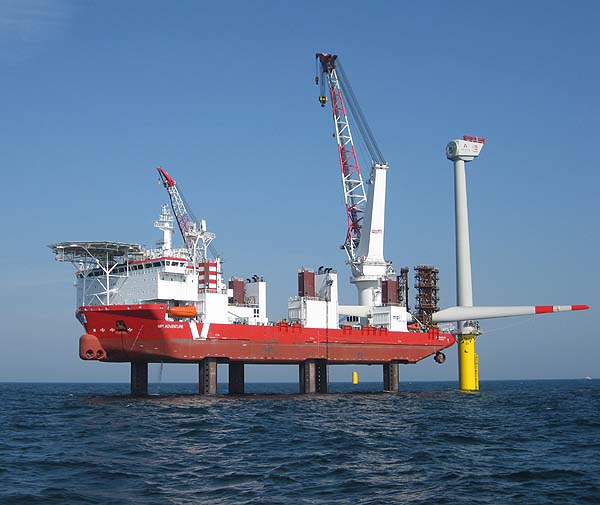
The project proved exceptionally difficult due to a delayed grid connection, resulting claims, and failing contractors. It placed high demands on the owner-side project management.
| 2012 − 2014 |
| Project Owner: | Trianel Windkraftwerk Borkum GmbH & Co. KG |
| Function: | Technical and Commercial Project Controlling, Technical Project Coordinator Installation Campaign |
Trianel Windpark Borkum I (TWB I)
The offshore wind farm Trianel Windpark Borkum I (TWB I) is the first construction phase of the Trianel Windpark Borkum and went online in 2015. The offshore site covers 56 square km and is located about 45 km north of the island Borkum in the German Bight. The water depth ranges here from 25 to 35 meters. The estimated yearly power output amounts to 750 GWh. TWB I comprises 40 AREVA wind energy converters (WEC) of the 5 Megawatt class with a total nominal output of 200 MW and a total height above water level of 148 meters. The turbines with a total weight of more than 1000 tonnes are erected on tripod foundations with an average weight of 700 tonnes. The AC converter station is already equipped to serve the second construction phase as well (TWB II).
The one Billion Euro project is held by a cooperation of 33 municipal and regional utilities and Trianel GmbH. The special purpose vehicle (SPV) for the project is Trianel Windkraftwerk Borkum GmbH & Co. KG.
Interface Management and Multi-Contracting

Johannes Dimas was in charge of the Technical and Commercial Project Controlling for the subprojects (wind energy plant, foundations, cables, substation and logistics). During the construction phase, as the Technical Project Coordinator Installation Campaign, he managed the two separately assigned packages Wind Turbines and Installation Logistics until handover to the commissioning team.
Not least due to the delay in the grid connection, the TWB I project proved exceptionally difficult. Resulting claims, failing contractors and also an inhomogeneous and partly externally assembled project team placed high demands on the owner-side project management, in particular against the background of the chosen multi-contracting strategy.
Videos about the project TWB I
Jump to the description of the second construction phase TWB II
Website of TWB I: www.trianel-borkum.de
International Business Development (FDI)
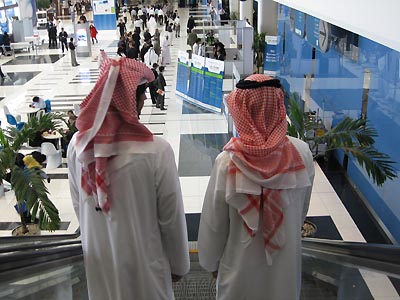
The consulting services were offered by Germany Trade & Invest GmbH (GTAI), a 100% subsidiary of the German Federal Ministry for Economic Affairs and Energy (BMWi).
| 2009 − 2011 |
| Project Owner: | Major international companies, e.g. GE Central Europe |
| Function: | Division Manager Wind Energy & Hydro Power at GTAI |
Setting Up Business

Between 2009 and 2011 Johannes Dimas gave advice to major international companies of the wind industry from Europe, USA, and Asia on behalf of Germany's federal government. Key aspects were Foreign Direct Investments (FDI). The consulting services were offered by Germany Trade & Invest GmbH (GTAI), a 100% subsidiary of the German Federal Ministry for Economic Affairs and Energy (BMWi).
Johannes Dimas built up the wind energy division at GTAI. The services included industry business opportunity analyses, market research, industry site analysis, and Project-related financing and incentives consultancy.
One of the mandates concerned the Offshore Wind Expansion Program of GE Energy. In the year 2010, GE announced to invest 340 million Euro in offshore technologies. Investments were made in Germany (Hamburg, Salzbergen), UK, Norway, and Sweden.
Find several publications with regard to Business Development and FDI in the Publications & Presentations section, e.g. "The Wind Energy Industry in Germany - Issue 2010/2011".
HV-Transmission Line Baltic I
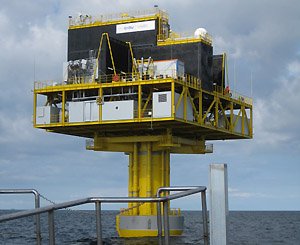
For Vattenfall Europe Transmission, this was the first High Voltage (HV) transition line for an offshore wind farm.
| 2007 − 2008 |
| Project Owner: | Vattenfall Europe Transmission GmbH (since 2010: 50Hertz Transmission GmbH) |
| Function: | Division Manager Western Baltic Sea (Cluster West) at Vattenfall Europe Transmission GmbH, Project Director Baltic 1 |
HV-Grid Connection for the Offshore Wind Farm Baltic 1
The Baltic 1 wind farm is operated since 2011 by the German utility ENBW AG. The 21 turbines sum up to a capacity of 48.3 MW in total. The 150 kV grid connection has a length of approximately 77 km (16 km onshore, 61 km offshore). It links the substation shared with the wind farm Baltic 1 and the Bentwisch onshore substation near Rostock.
Due to short-term changes in the legal framework, the responsibility for the grid connection of an offshore wind farm was transferred from the project developers to the grid operators at that time. This meant that the transmission system operators had to quickly establish a functioning project organization and - as far as the offshore side was concerned - enter new technical territory.

As Division Manager for the western Baltic Sea (Cluster West) Johannes Dimas was the Project Director in charge for the on- and offshore Transmission Line Wind Farm Baltic I. This included the project set-up, front-end engineering (FEE), and the European tender procedure. The budget summed up to ~150 million Euro.
For Vattenfall Europe Transmission, this was the first High Voltage (HV) transition line for an offshore wind farm. In 2010 “Vattenfall Europe Transmission GmbH” was sold and is operating now under the name of “50Hertz Transmission GmbH”.
Wind Farms in The Free State of Thuringia
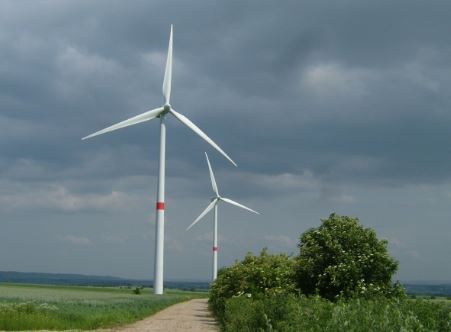
The onshore wind farm projects are parts of a broader wind farm area located in the Free State of Thuringia (Germany).
| 2003 − 2008 |
| Project Owner: | EnerPlan GmbH (developer) |
| Function: | Expert (Sachverständiger) |
Rastenberg Projects

The wind farm projects Rastenberg I and II are parts of a broader wind farm area located in the Free State of Thuringia (Germany).
Johannes Dimas - Energy & Project Management did provide the approval documents (BImSchG) for both wind farm projects on behalf of the project developer EnerPlan GmbH. He supported the approval process and gave expert advice with regard to several technical and environmental issues.
Rastenberg II
The project Rastenberg II expanded the capacity of the existing site Rastenberg/Roldisleben with three additional wind energy converters: Two Gamesa G80-2.0 with a nominal capacity of 2 Megawatt each and one smaller Enercon - E 40 with 600 kW. The turbines are in normal operation since 2008.
Rastenberg I
The 8 Megawatt wind farm project Rastenberg I consists of four Gamesa wind energy converters with a nominal capacity of 2 Megawatt each. The wind farm was build in 2005 and is in normal operation since 2006.
Further Wind Farm Projects
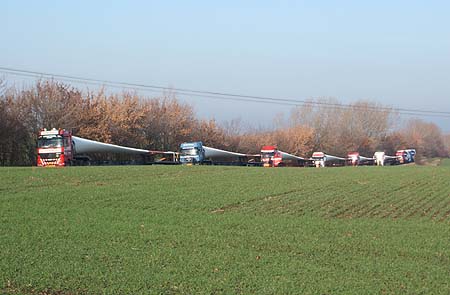
On a smaller scale, Johannes Dimas - Energy & Project Management supported with its consultancy services further wind farm projects of the EnerPlan GmbH in the Free State of Thuringia - amongst others the projects Kleinbrembach, Sotterhausen (6 MW), and Vogelsberg (6 MW).
Offshore Wind Farm alpha ventus
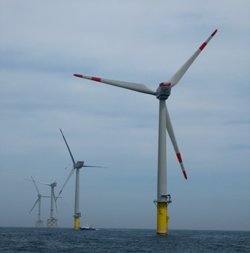
The first German offshore wind farm was a ground-breaking pioneer work and the starting point for the the German offshore wind sector of today.
| 2006 − 2007 |
| Project Owner: | Deutsche Offshore-Testfeld und Infrastruktur GmbH & Co. KG (DOTI). Shareholder are EWE AG (47,5%), E.ON Climate & Renewables (26,25%) and Vattenfall Europe Windkraft (26,25%) |
| Function: | Package Manager Foundation, Logistic and M&O (Vattenfall Europe) |
The German Pioneer Project

Alpha ventus is the first German offshore wind farm and was a ground-breaking pioneer work of the three involved utilities. The wind farm is a joint venture of EWE AG, E.ON Climate & Renewables und Vattenfall Europe Windkraft. In 2006, they founded Deutsche Offshore-Testfeld und Infrastruktur GmbH & Co. KG (DOTI) as special purpose vehicle (SPV) for the project. For all involved parties, alpha ventus was the starting point for an enduring engagement in the German offshore wind sector.
The site is located 45 km off the island Borkum in the German Bight. The wind farm launches six AREVA Multibrid M5000 converters on tripod foundations and six Repower 5M on jacket foundations. The offshore substation was already erected in 2008. The start of normal operation was celebrated on 27th of April 2010. With a nominal capacity of 60 Megawatt the wind farm is designed for a yearly production of about 220 gigawatt hours. This energy yield is sufficient to provide 50.000 four-person households with renewable energy.
Merging Technology and Management
With respect to both, the technology and the project management, alpha ventus was a challenging project for all involved organisations. Within the joint venture Johannes Dimas led the Vattenfall team that did staff the foundation, the logistic and the M&O package. He was responsible for the conceptual planning, the budgeting, the Front-End Engineering (FEE) and the procurement by tender.
Strategic Business Development
The trigger for the commitment of Vattenfall Europe was Vattenfall Europe's offshore strategy, which was mapped out by Johannes Dimas together with the Vattenfall Headquarters. As a result, Vattenfall acquired DanTysk as well as shares on the alpha ventus offshore project.
Video about the project alpha ventus
Jump to Vattenfall Europe's Offshore Strategy
Offshore Wind Farm DanTysk

The application documents for the licensing have set standards for all future projects. In 2018, DanTysk was awarded as the "Best Offshore Wind Farm in Operation 2017".
| 2000 − 2007 |
| Project Owner: | DanTysk Offshore Wind GmbH - a Joint Venture of Vattenfall (51%) and Stadtwerke München (49%) |
| Function: | Division Manager Wind Power at Vattenfall Europe Renewables GmbH Project Director Grid Connections, and Project Engineer at GEO mbH |
Large Scale Utilisation of The Offshore Wind Energy in Germany
Vattenfall and the Munich utility Stadtwerke München (SWM) constructed the offshore wind farm DanTysk about 70 kilometres western of the island Sylt in a water depth of 21 to 31 meters. The first turbine was erected in April 2014, the first power was supplied in December 2014.
Vattenfall and SWM have founded the special purpose vehicle (SPV) DanTysk Offshore Wind GmbH (Vattenfall 51%, SWM 49%). Vattenfall had been responsible for the construction and is now operating the wind farm.
In December 2010 Vattenfall's board of directors took the final investment decision in Stockholm. In the same period, Vattenfall and SWM signed the supply contract of the offshore converter station. The substation was installed in August 2013 by a consortium of Strukton and Hollandia.
The 80 wind energy converters with a nominal capacity of 3.6 Megawatt (MW) and a rotor diameter of 120 meters were delivered by Siemens. The wind farm with a total capacity of 288 MW provides electricity for 500.000 households.
In 2018, DanTysk was awarded as the "Best Offshore Wind Farm in Operation 2017" by the Arbeitsgemeinschaft Offshore-Windenergie e.V.
Setting Standards
The application for approval of DanTysk was one of the first for an offshore wind farm in the German Exclusive Economic Zone (EEZ). Johannes Dimas did work in a small team on the project development comprising the environmental impact assessment, the first technical concepts as well as the approval procedure. The conception and the quality of the application documents including the underlying environmental impact study (EIS) have set the standards for all future application processes executed by the Federal Maritime and Hydrographic Agency (BSH).
Strategic Business Development
Much later - at this time responsible for the wind energy at Vattenfall Europe - Johannes Dimas was mapping out Vattenfall Europe's offshore strategy with the Vattenfall Headquarters. As a result, Vattenfall acquired DanTysk as well as shares on the alpha ventus offshore project.
Videos about the project DanTysk
Jump to Vattenfall Europe's Offshore Strategy
Wind Farm Jänschwalde
The first wind farm which was constructed by a Vattenfall Europe company and the beginning of a continuously increased wind power portfolio.
| 2006 |
| Project Owner: | Vattenfall Europe Renewables GmbH |
| Function: | Division Manager Wind Power at Vattenfall Europe Renewables GmbH Project Director Construction and Commissioning Wind Farm Jänschwalde III |
Reducing The Carbon Footprint – The First Cut
The wind farm Jänschwalde is situated close to the city of Cottbus in the federal state of Brandenburg in the direct neighbourhood of an open brown coal pit, formerly run by Vattenfall. It is the first wind farm which was constructed by a Vattenfall Europe company itself, namely Vattenfall Europe Renewables GmbH. In the meantime, Vattenfall fully divested its brown coal mining and lignite-fired power generation in Germany to reduce its carbon footprint and besides did continuously increased its wind power portfolio.
The first construction stage of Jänschwalde was commissioned in 2004, the final in 2006. The six 2 MW Vestas V90 turbines with a hub height of 105 meters sum up to a total capacity of 12 MW. Johannes Dimas was the project manager for the construction and commissioning of the final three turbines (6 MW). As the Division Manager Wind Power at Vattenfall Europe Renewables GmbH, Johannes Dimas was also in charge for the maintenance and operation of the wind farm Jänschwalde.
Vattenfall Europe's Offshore Strategy

The screenplay for Vattenfall Europe's entry into the offshore wind energy sector, followed by various M&A projects.
| 2005 − 2006 |
| Projektträger: | Vattenfall Europe, Vattenfall Europe Renewables GmbH |
| Funktion: | Lead Wind Power, Head of Commercial-Technical Due Diligence Teams |
Strategic Corporate and Business Development

Vattenfall GmbH, formerly Vattenfall Europe, is a wholly owned subsidiary of the state-owned Swedish energy company Vattenfall AB. Vattenfall Europe has long been criticized for its open cast mining and coal-fired electricity generation. In the meantime, Vattenfall has completely divested its open cast mining and coal-fired generation in Germany in order to reduce its CO2 emissions. In addition, Vattenfall has continuously expanded its wind power portfolio.
Since the board approval of the Vattenfall Europe's Offshore Strategy, the engagement focusses on the offshore wind energy sector. Today, Vattenfall is one of the main players in the offshore wind energy sector and has bundled offshore wind energy as a future-proof core area throughout the Group.
Vattenfall Europe's Offshore Strategy
The screenplay for Vattenfall Europe's entry into the offshore wind energy sector was the strategy for Vattenfall Europe's strategic alignment in the offshore segment. The strategy was largely developed by Johannes Dimas together with the Corporate Development in Berlin and then presented to the decision-making boards.
As part of a broad-based market analysis, almost all of the German offshore projects available at that time were subjected to a technical and economic review. Johannes Dimas, at that time responsible for the wind energy at Vattenfall Europe Renewables GmbH, was leading the commercial-technical due diligence teams.
Implementation
Based on the Offshore Strategy, Vattenfall Europe conducted the acquisition of the DanTysk offshore wind farm project and realised its participation in the alpha ventus project as well as the share-deal wit regard to the Borkum Riffgrund 1 project. The renewable energies, that were at that time assigned to the Vattenfall Europe Generation AG or more specifically to the Vattenfall Europe Renewables GmbH, were first bundled in an independent business unit in Hamburg and later bundled group-wide. In the course of the divestment of the German fossil energy units, the Vattenfall Europe Generation AG was sold in 2016 (today Lausitz Energie Kraftwerke AG).
After having paved the way, Johannes Dimas also worked on the realization of the above mentioned key projects:
Baltic Sea Wind Farms and Measurement Mast
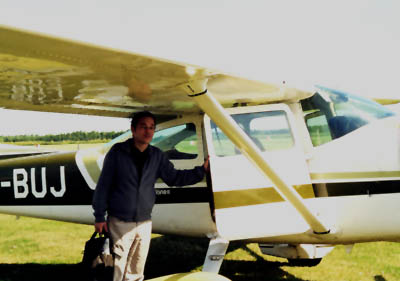
The first German offshore measuring tower was erected in 2002. Beforehand, the first drillings for a wind farm development in the German Baltic Sea were conducted.
| 2000 − 2003 |
| Project Owner: | Beta Baltic: E.ON (prior GEO mbH) GEOFReE: GEO mbH |
| Function: | Surveyor (Feasibility Study), Client Rep, Project Manager Grid Connection |
Germany's First Offshore Wind Measuring Mast
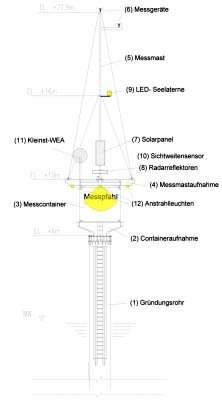
In 2002 the first German offshore measuring tower was built in the Mecklenburg Bay (Baltic Sea) by order of E.ON. In the preliminary stages extensive investigations of the environment and the site were carried out.
The measuring mast is located in the planning area of the wind farm Beta Baltic (formerly SKY 2000) and the planned test field GEOFReE. The offshore installation collects meteorological and hydrographical data. The data are temporarily stored on a data logger inside a converted container and transmitted by radio to the mainland.
The foundation of the measuring mast consists of a steel monopile; nearly 60 m long, and 110 t heavy. The measuring container is installed 6 m above the water line. A 12 m high measuring mast is attached to the container.
Already during the installation data about the pile-driving process, the noise emissions, and about the sediment drift were collected. The pile-driving was very challenging and confirmed the assumptions of the ground expertise.
Offshore Wind Farm Beta Baltic
Beta Baltic, formerly known as SKY 2000, is a wind farm project in the German territorial waters of the Baltic Sea. It was developed by GEO mbH and later acquired by E.ON and transferred to the special-purpose vehicle (SPV) Offshore Windpark Beta Baltic GmbH. The distance to the main land is about 20 km; water depths vary about 20 meters. The project is since several years on hold, not at least because of the difficult ground conditions (see below).
Test Field GEOFReE
GEOFReE (GErman Offshore Field for Renewable Energy) is a test field planned by GEO mbH for up to five wind energy converters adjacent to the Beta Baltic project.
Environmental Impact Studies and Regional Planning

Johannes Dimas did promote the regional planning procedure, environment impact studies, and the approval procedure of the wind farm Beta Baltic / SKY 2000 on behalf of the former project developer GEO mbH from 2000 till 2003.
In the year 2002 he became the project manager for the regional planning procedure of the grid connection. Later, due to a change in the law, the transmission grid operator (50 Hertz) took over the responsibility relating to the planning and realisation of the grid connection.
Geological Offshore Surveys
Several geophysical surveys and a following drilling campaign were carried out at the planned site of the two wind farm projects and the measurement mast, because a first feasibility study carried out in 2000 by Johannes Dimas indicated problematic site conditions due to unconsolidated sediments.
In the following, several seismic surveys were undertaken by different geoscientist conducting various geophysical measurements. The results of all these surveys seemed to dispel the concerns regarding problematic subsoil.
However, the drilling campaign in 2002, also supervised by Johannes Dimas, could not verify the results of the seismic surveys.
On the planned site and the surrounding area the sea-bottom is built up of juvenescent, unconsolidated alluvial mud. Underneath, there are more Holocene soft sediments with very little bearing capacity. The total thickness of the Holocene sediments according to the drillings is between 14 m and 19 m. Underlying this strata is glacial till and claystone with adequate bearing capacity.
For detailed information about the geological site survey see DIMAS & OVERBECK (2003).
Geographic Information System (GIS)
Today, the use of GIS is established throughout the entire offshore wind energy sector.
| 2001 |
| Projektträger: | GEO Gesellschaft für Energie und Oekologie mbH |
| Funktion: | Project Management |
Implementation of a Geographic Information System (GIS) for the North and Baltic Seas
In 2001, Johannes Dimas implemented a Geographic Information System (GIS) at the project developer GEO mbH. In the GIS, all geo-referenced data of the various projects in the North and Baltic Seas were merged and managed centrally. This also included the shore-side grid connections.
For a reliable data exchange, special arrangements had been closen with all involved, such as wind and environmental experts. On this basis, an integrative project development approach was promoted. Above all, this approach focuses on interface optimization and the utilisation of synergies.
Today, the use of GIS has proved to be the best way to manage the high data amount and is established throughout the entire offshore wind energy sector.
Geological Survey in the Black Forest
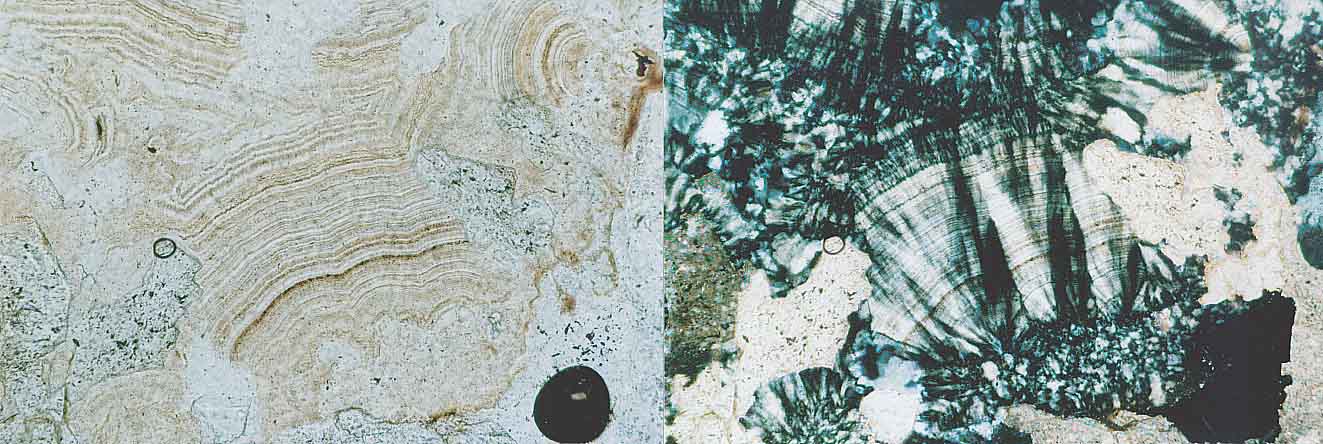
A new understanding of the geological and hydrogeological conditions in the region.
| 1998 − 1999 |
| Project Owner: | Johannes Dimas in cooperation with the Geological State Office Baden-Württemberg( 1998 − 1999) |
| Funktion: | Diploma student at the Geological Institute Freiburg i.Br. |
Geological Mapping and Lithostratigraphic Analysis

In 1999, the geological recordings of the area northwest of Alpirsbach in the Middle Black Forest were completed. The mapping and the stratigraphic investigations were carried out in cooperation with the Geological State Office Baden-Württemberg.
The refined lithostratigraphy opens up a new understanding of stratification and deposition conditions and opens up a new understanding of the geological and hydrogeological conditions in the region beyond the work area. In 2004, the results were used for supporting the Alpirsbacher Klosterbräu Glauner GmbH & Co. KG on prospecting new brewing water in the region.
An overview profile of the Permo-Triassic overburden and a refined lithostratigraphic subdivision based on profiles of the Thuringium (z) were published in 1998/1999.
DIMAS, J. (1999): Das permische und triassische Deckgebirge nordwestlich von Alpirsbach
Learn more about our Expertise
Personal references of Johannes Dimas. The scope of work was provided as employee or consultant. The list is not exhaustive.

